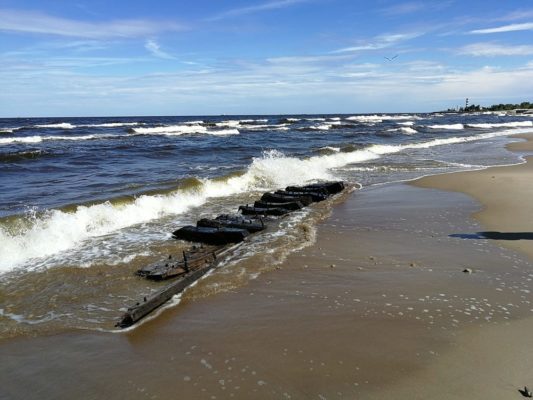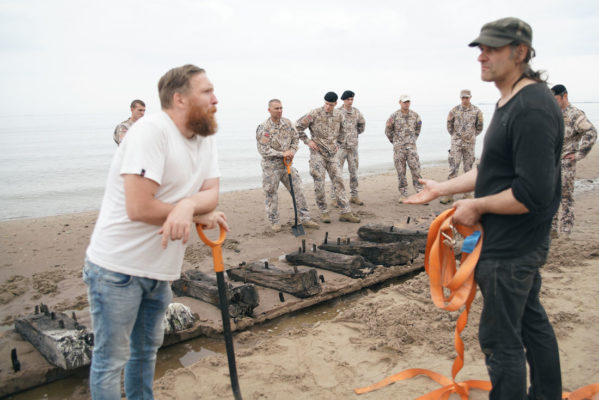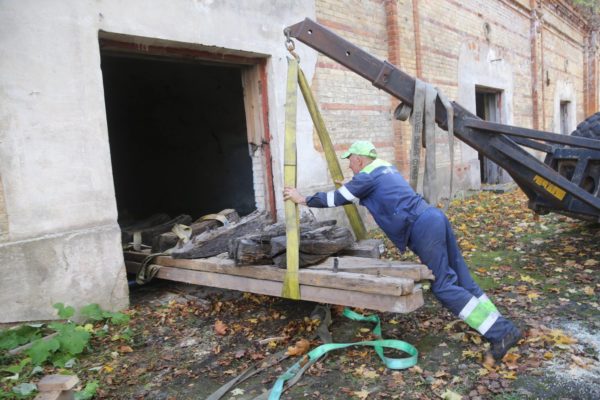


On 19th October 2018, in the Daugavgriva Fortress, a part of the sailboat wreck keel part with frames was placed between in the casemate between bastions “Sietiņš/Pleiades” and “Greizie rati/Ursa major”.
The relocation of the wreck parts was done thanks to the member of the association “Rīgas Kuģis/Riga Ship” and “Senā osta/Ancient Port” Andis Bunkšis and the technique and employees of his company “WT Terminal”, as well as Sandra and Vladimirs Jakušonoks, Kaspars Rubenis, Jurijs Jefremenkovs, Sergejs Domanovs, Viktorija Krasnoplaha.
It is planned that the ship’s remains will be stored in a special box with sand. Currently, this historic discovery (the property of the Museum of History of Riga and Navigation) is located in a shady and well-ventilated casemate.
Experts still determine the timber from which the ship was made – it could be spruce or pine for keel and oak for frames or ribs that dull in water. Also, the best form of preservation has not yet been determined. The best suggestions for storing the wreck have so far been made by experts Māris Zunde and Jānis Asaris.
The historic shipwreck was washed out near the Daugavgriva pier on 4th July 2018. The historians of the Museum of the History of Riga and Navigation originally are dating this ship’s remains back to the 17th century, because the details were tied with wooden pins. Ancient ship researcher and underwater archaeologist Voldemārs Rains assumes that the ship found on the Daugavgriva coast could be also from the 19th century, because when the local fishermen built the boats in the villages of Latvia, they also used wooden pegs because it was more profitable and cheaper.
The total weight of the wreck is between 1.5 and 2 tons, the length of the longest part is 8.5 meters, so it was not possible to simply hand the wreck from the sea to the land, and also it was problematic to lift it with heavy equipment in seashore.
The first wreck transportation works were launched on July 13, 2018. In wreck transportation participated it’s finder Artūrs Nikolajevs, the Volunteer Group from Bolderaja and Daugavgriva (Igors Dobičins with son, Valdis Gavars with family, Edgars Engīzers with son, Igors Makarenkovs, Sergejs Domanovs), Bolderaja Group Activists (Sandra un Vladimirs Jakušonoki, Kaspars Rubenis),14 National Armed Forces militarists from Patrol Boat Squadron, Mine Ship Squadron and Marine Incident Prevention Unit, as well as art scientists, restorers. They dug the wreck with shovels and then moved it with the help of straps moved it to the prepared beams and flat boards.
The wreck movement was promoted by specialists of the National Heritage Board, Museum of History of Riga and Navigation, Vice Admiral Gaidis Zeibots, Ineta Krasko, Taņa Gvozdeva, Ieva Īzāka with children. The event was promptly coordinated by the executive directorate of Pardaugava, the Nature Conservation Agency, the Freeport of Riga Police.
In addition, small logs and plywood sheets were used to facilitate work. The wreck was rolled forward, just like it was done in ancient times, delivering ships and large boats from their place of construction to the sea. Most part of the relocation was done by hand, because on the sand it was difficult to determine how durable the wreck was and what load it can withstand. Wreck in some parts of the road was dragged by a microbus, in this leg the task of the helping hands was to move the logs where the wreck was rolled. Totally wreck was moved about 300 m away from the initial washed out place to the dunes, where it was lifted by the enterprise “WT Terminal” (which is directed by Andis Bunksis) crane and slowly moved to the nearby “WT Terminal” area, where it was located until 19th October 2018.
More information:
https://www.facebook.com/daugavgrivas.cietoksnis/ Post in 19th October 2018
https://www.riga.lv/lv/news/vertigais-atradums-pludmale-koka-kuga-atluzas-nodotas-muzejam?14227
https://www.facebook.com/Latvijasarmija/ Post in 13th July 2018
